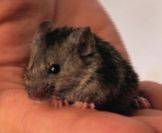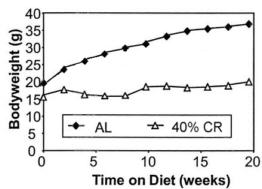The Calorie Restriction Paradox

CR mice weigh only half as much as non-restricted mice
Calorie Restriction is well established as a method for increasing the average life span of many experimental animals. If after weaning, you feed mice 40% less that what they would normally eat, the mice virtually stop growing in size. At maturity, the calorie restricted mice weigh only half as much as the mice fed a normal diet. The following chart shows the weight gain of the normally fed mice and the almost constant weight of the restricted mice:

The non-restricted mice eat F grams of food per W grams of body weight (F/W). The restricted mice eat 0.6 grams of food per 0.51 grams of body weight (0.6 F/0.51 W).[1] However, 0.6/0.51 is 1.18 F/W which corresponds to 18% more food per unit of body weight.
This is the paradox: How can a rodent that, on a body weight basis, eats proportionally more than the control accrue the benefits of longevity?
[1] Mattson, et al. "Intermittent fasting dissociates beneficial effects of dietary restriction on glucose metabolism and neuronal resistance to injury from calorie intake", Proc Natl Acad Sci USA, 2003 May 13; 100(10):6216-6220.
© Copyright - Antonio Zamora

